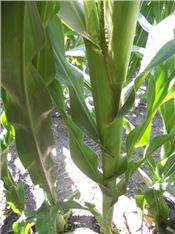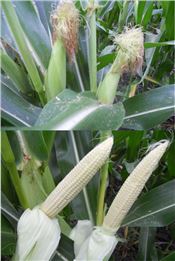Assessing Potential Of The 2022 Corn Crop
DR. EMERSON NAFZIGER
URBANA, ILLINOIS
Nearly all of Illinois received below-normal rainfall in June, with the lowest amounts found in east central Illinois. In contrast, most of the state has received above-normal rainfall in July, with very high totals in parts of southern Illinois, above-normal amounts in much of northern Illinois, and a strip of moderately below-normal rainfall that roughly follows I-74 from the Quad Cities to Danville.
The US drought map from last week (July 21) has about a third of the state as abnormally dry, with about 2 percent (centered in southern Champaign County) in severe drought. That is an improvement over the previous week, and rainfall the last week of July should bring further improvement.
One of the benefits of dry June weather is that roots were able to develop well, and little or no water stood in fields to damage roots.
Retention of nitrogen was good, although some late applications may not have gotten into the crop as quickly as hoped. There is little foliar disease, and while daytime temperatures have been above normal on many days, temperatures this summer have averaged only slightly above normal. Sunshine has been plentiful. All in all, it has been a very good growing season up to now. Stress that lingers in some areas will, though, be expected to take a toll.
The best gauge to use the measure the cumulative effect of stress due to low soil moisture on the crop is plant height, now that pollination is coming to an end (silking was at 80 percent on July 15, very close to the 5-year average.) Corn on the South Farm that was planted in mid- May is short, with the top leaf collar (often used to designate height) at only 5 to 6 feet in most fields. In areas with better rainfall, corn planted in mid-May may be taller than normal, as the result of warm temperatures and plentiful water during elongation of stalk internodes in June and early July.
Does short corn mean less yield? We have had years in Illinois when corn shortened by early-season dryness produced very good yields. One such year was 2017, which included dryness late in the season as well.
If wet weather delays planting and then persists, plants are not only taller than normal, but there can be more damage from standing water, and stalks may be smaller in diameter than normal. This can all add up to lower yields and standability issues, especially if it turns dry during grainfill. We’d certainly choose a year like 2022 over one that stays wet through June, and having adequate rains during July after a dry June is a combination that works well to produce high yields.
One new wrinkle in the debate about corn plant height and yield is the development of corn hybrids that are bred to be shorter than normal without losing yield potential. These have not yet been released commercially, although some short-growing hybrids have been marketed for years. I was recently in a field planted to one of these hybrids, where I took the photo below (Figure 1) showing how the internodes below the ear are shortened to a few inches. Dry weather may have shortened these more than usual. The internodes above the ear were of normal length, but plants were only about five feet to the top leaf collar. Leaves appeared to be normal size, and light interception looked to be good, although, as in most of the corn fields in the (dry) area, more sunlight was reaching the ground than we’d consider ideal.
Normal-height corn in areas where there has been enough water to minimize stress so far should set good to very good numbers of kernels this year. Most fields that pollinated in the middle of July (the 50 percent silking date in Illinois was July 15 this year) now have brown silks, and most are in R2 stage, called the “blister” stage from the appearance of the kernels. It typically takes about 250 growing degree days to go from pollination (R1) to R2 – that’s about 10 days at normal July temperatures.
It takes another 250 GDD or so to go from stage R2 to R3 – the “roasting ear” stage, when kernels (of yellow corn) take on the shape and color of yellow sweet corn kernels. Kernels at stage R2 can abort when conditions are stressful or when there are more kernels than the plant has the capacity to fill. We think the rate at which sugar comes into the cob is the signal for keeping or aborting kernels. Once kernels reach stage R3, they are very likely to continue to fill and to contribute to yield. That is, we consider them safe from abortion, and although the plant’s ability to fill them depends on conditions during the remainder of grainfill, kernel count at R3 is a good indicator of yield potential for a field.
We often focus on how many kernels each ear has, but the important number is how many kernels there are per acre. That requires counting how many ears there are per acre (we usually count ears in 1/1000th of an acre when sampling.) We next pull three or four ears from the section of row used for the ear count, and we count number of rows and kernels per row on each ear, then multiply these to get kernels per ear. We then average the number of kernels per ear, and multiply that average times the number of ears per acre to calculate the number of kernels per acre. As an example, a field with 34,000 ears per acre and an average of 560 kernel per ear (16 rows x 35 kernels per row) has 19,040,000 kernels per acre. The final step in estimating yield is use a guess at final kernel size (we normally use 80,000 kernels per bushel) to calculate bushels per acre. In our example, using 80,000 kernels per bushel would forecast a yield of 19,040,000/80,000 = 238 bushels per acre.
Kernel counts are more accurate once ears reach stage R3, but ears at stage R2 can show how successful pollination has been, and can approximate the potential number of kernels. I’ve been watching as corn has encountered stress over the past six weeks here in Champaign County, and I recently took the photos shown below (Figure 2.) The upper photo shows silks that are mostly turning brown, with the exception of some silks in the center of the silk mass. These two plants, although they both have good leaf color, illustrate the variability in stalk diameter and ear size that is common in many fields that have experienced stress. If we look closely, we can also see that the ear on the right has slightly smaller “blister” kernels than the one on the left, probably due to being a day or so later in pollinating.
It is too early to get solid kernel counts from these ears, but there are signs form these and other ears I’ve sampled that final kernel number in some fields may not be as high as the crop needs for high yields. Both of these ears have 16 rows of kernels, and around 35 “blisters” per row. Both have some silks (at the tip of the ear, where they remain attached) that did not get pollinated, but that is not a major issue. More importantly, both ears, but especially the one on the right, appear to have spaces along kernel rows where kernels did not form. These will soon become noticeable “blanks” as viable kernels get larger. If the flow of sugars into the ear is lowered for any reason (dryness, cloudy weather) this number could rise.
Cooler, cloudy weather this week is providing a break from the heat of recent weeks, which will slow growth and help preserve water. The key to crop prospects will be how many kernels reach stage R3 (in early August) and then are able to fill rapidly and completely for the 30 days after that. Today’s hybrids are bred to produce and to fill high kernel numbers, and we fully expect that to happen in fields where stress has been limited. Where stress has been noticeable during most of July, lower kernel numbers may mean lower kernel numbers and yields. ∆
DR. EMERSON NAFZIGER: Research Education Center Coordinator, Professor, University of Illinois

Figure 1. Leaves below the ear in a “short” corn hybrid.

Figure 2. Corn plants at stage R2 on July 26, 2022 near Champaign, Illinois. The upper photo is intact plants; the lower is the same plants with husks removed.